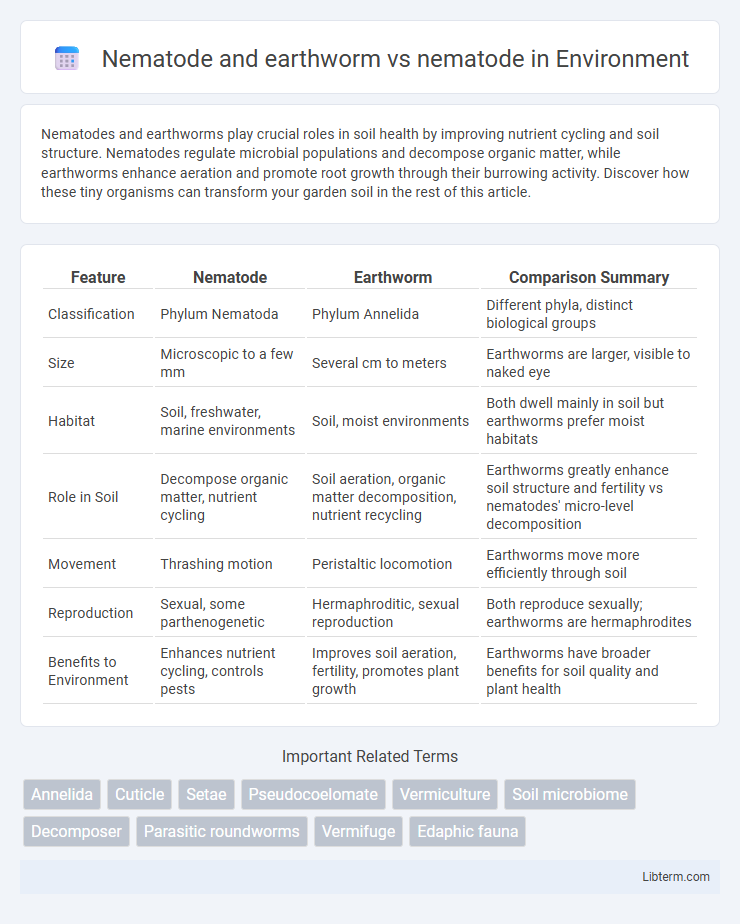Nematodes and earthworms play crucial roles in soil health by improving nutrient cycling and soil structure. Nematodes regulate microbial populations and decompose organic matter, while earthworms enhance aeration and promote root growth through their burrowing activity. Discover how these tiny organisms can transform your garden soil in the rest of this article.
Table of Comparison
| Feature | Nematode | Earthworm | Comparison Summary |
|---|---|---|---|
| Classification | Phylum Nematoda | Phylum Annelida | Different phyla, distinct biological groups |
| Size | Microscopic to a few mm | Several cm to meters | Earthworms are larger, visible to naked eye |
| Habitat | Soil, freshwater, marine environments | Soil, moist environments | Both dwell mainly in soil but earthworms prefer moist habitats |
| Role in Soil | Decompose organic matter, nutrient cycling | Soil aeration, organic matter decomposition, nutrient recycling | Earthworms greatly enhance soil structure and fertility vs nematodes' micro-level decomposition |
| Movement | Thrashing motion | Peristaltic locomotion | Earthworms move more efficiently through soil |
| Reproduction | Sexual, some parthenogenetic | Hermaphroditic, sexual reproduction | Both reproduce sexually; earthworms are hermaphrodites |
| Benefits to Environment | Enhances nutrient cycling, controls pests | Improves soil aeration, fertility, promotes plant growth | Earthworms have broader benefits for soil quality and plant health |
Introduction to Nematodes and Earthworms
Nematodes are microscopic, cylindrical worms found in diverse environments, playing crucial roles in soil nutrient cycling and plant health. Earthworms, significantly larger and segmented, enhance soil structure and fertility by aerating soil and decomposing organic matter. Both organisms contribute to soil ecosystems, but nematodes primarily regulate microbial populations while earthworms physically modify the soil environment.
Classification and Biological Differences
Nematodes belong to the phylum Nematoda and are unsegmented roundworms, whereas earthworms are segmented worms classified under the phylum Annelida. Nematodes exhibit a pseudocoelomate body plan with a simple digestive system, while earthworms possess a true coelom and a more complex digestive tract. Additionally, nematodes are primarily microscopic and have a cuticle that molts, whereas earthworms are larger, visible to the naked eye, and have a moist, soft body without molting.
Morphological Features: Nematode vs Earthworm
Nematodes exhibit a cylindrical, elongated, and unsegmented body covered by a tough cuticle, while earthworms have a segmented, soft, and cylindrical body with visible annuli and setae on each segment. Nematodes possess a pseudocoelom and lack distinct respiratory and circulatory systems, whereas earthworms have a true coelom, a closed circulatory system, and breathe through their moist skin. The difference in body segmentation and internal anatomy are key morphological features distinguishing nematodes from earthworms.
Habitat and Environmental Preferences
Nematodes thrive in diverse environments, from soil and freshwater to marine ecosystems, often favoring moist, nutrient-rich habitats where organic matter is abundant. Earthworms primarily inhabit topsoil layers rich in organic material, requiring moist, aerated environments to support respiration and nutrient cycling. Unlike nematodes, earthworms prefer stable, well-aerated soil conditions and play a crucial role in soil structure and fertility, while nematodes adapt to a broader range of ecological niches including extreme environments.
Feeding Habits and Digestive Systems
Nematodes exhibit diverse feeding habits, ranging from bacterial feeders to plant parasites, using a simple tubular digestive system with a muscular pharynx for nutrient intake. Earthworms consume soil rich in organic matter, utilizing a complex digestive system featuring a crop, gizzard, and intestine to break down and absorb nutrients effectively. While nematodes rely on a straightforward digestion process suited for various microscopic food sources, earthworms possess a more specialized system allowing efficient decomposition of organic material and soil aeration.
Role in Soil Ecology and Fertility
Nematodes contribute to soil ecology by regulating microbial populations and decomposing organic matter, enhancing nutrient cycling essential for soil fertility. Earthworms improve soil structure, aeration, and nutrient availability through their burrowing and casting activities, which promote microbial activity and organic matter breakdown. Unlike nematodes, earthworms physically modify soil texture, creating channels that enhance water infiltration and root growth, making them key ecosystem engineers in soil health management.
Parasitic vs Beneficial Species
Nematodes include both parasitic species that infect plants, animals, and humans, causing diseases and agricultural damage, as well as beneficial species that enhance nutrient cycling and biological pest control. Earthworms are predominantly beneficial soil organisms that improve soil structure, nutrient availability, and microbial activity without parasitic traits. While nematodes have diverse ecological roles ranging from harmful parasites to mutualistic agents, earthworms function consistently as ecosystem engineers promoting soil health.
Reproduction and Life Cycles
Nematodes reproduce primarily through sexual reproduction, with distinct male and female individuals, and some species capable of parthenogenesis, exhibiting rapid life cycles ranging from days to weeks depending on environmental conditions. Earthworms are hermaphroditic, possessing both male and female reproductive organs, and reproduce through mutual copulation followed by cocoon formation, with life cycles spanning several months to years. The nematode's simple, short life cycle facilitates quick population growth, while the earthworm's longer, more complex cycle supports ecosystem soil health over extended periods.
Economic and Agricultural Impact
Nematodes, particularly plant-parasitic species, cause significant economic losses by reducing crop yields and quality through root damage and nutrient depletion, whereas earthworms enhance soil fertility and structure by decomposing organic matter and promoting nutrient cycling. Infestations of harmful nematodes can result in millions of dollars in agricultural damage annually, demanding costly pest management strategies. In contrast, earthworm activity supports sustainable agriculture by improving soil aeration and water retention, leading to increased crop productivity and reduced reliance on chemical fertilizers.
Summary: Key Differences Between Nematodes and Earthworms
Nematodes are microscopic roundworms with unsegmented, cylindrical bodies and a simple digestive system, while earthworms are larger, segmented annelids with a complex digestive tract and visible ring-like segments. Nematodes inhabit diverse environments, often acting as parasites or decomposers, whereas earthworms primarily contribute to soil aeration and nutrient recycling through their burrowing activities. The structural and ecological distinctions between nematodes and earthworms impact their roles in ecosystems, with nematodes influencing microbial populations and earthworms enhancing soil fertility.
Nematode and earthworm Infographic

 libterm.com
libterm.com